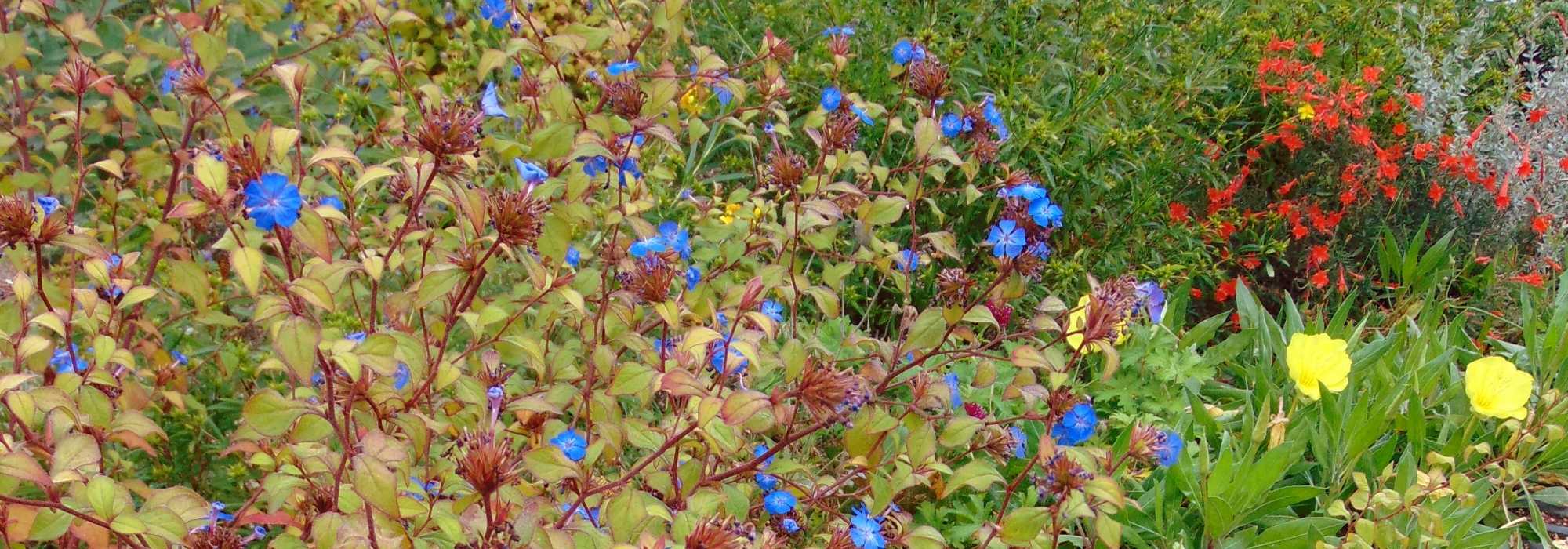
Ceratostigma, Chinese Plumbago: planting, pruning and care
Contents
Ceratostigmas, in a nutshell
- These shrubs or spreading perennial plants are characterised by late-summer to autumn flowers of an intense gentian blue.
- Formerly named Plumbago, these plants took the name Dentelaire because of their round corolla with distinctly notched petals that stand out against dark green foliage tinged with bronze to purple.
- They favour warm positions, from shaded to sunny, in gravelly, even dry soils that provide good frost resistance.
- Very easy to grow, Dentelaire de Larpent is used as groundcover on a bank or at the base of a bush, while the shrubby forms (griffitii and wilmottianum) create low hedges or combine with a border planted with bushes, bulbs or perennial plants.
A word from our expert
Genus Ceratostigma, formerly named Plumbago and charmingly nicknamed Dentelaire, ranges from the mat-forming, creeping perennial (Ceratostigma plumbaginoides, also called Lady Larpent’s plumbago), to a spreading shrub some 1 m high, as in species Ceratostigma griffithii and willmottiana.
These deciduous to semi-evergreen plants take time to resume growth in spring, sometimes as late as May. All are more or less considered perennials since they can resprout from the stump after severe frosts. They tolerate cold down to -15 to -20°C provided roots remain dry over winter.
Dentelaires are easily identifiable by the star-shaped form of the flowers, comparable to 5-petalled phlox, and above all by their electric blue colour of rare intensity. It lasts for many months, stretching from July through October–November, often accompanied by a lush dark-green foliage that takes on superb orange, purple or red tones in autumn. The somewhat loose clusters appear at stem tips as small tubular flowers with five triangular petals, enclosed in calyces and reddish bracts that are continuously renewed.
In the garden, these are warmth-loving, soil-adaptable plants provided soil is well-drained; they tolerate gravelly, poor soils and are relatively hardy, to the delight of any novice gardener.
The supple red stems, clothed in delicate, abundant dark-green foliage tinged with bronze of Ceratostigma plumbaginoides, especially offer an ideal, low-maintenance groundcover at the feet of upright plants when flowering wanes. Their pairing with yellow or orange flowers is superb: we like to pair them with bushy potentillas, equally adaptable, or with Sternbergia lutea, a small bulb that flowers yellow in late summer and retains its foliage through winter.
Dentelaires particularly highlight bushes with yellow foliage such as Spiraea bumalda ‘Goldflame’ and those that display autumnal golden colours such as Hamamelis, dogwoods with coloured stems, Physocarpus, or grasses in tawny hues…
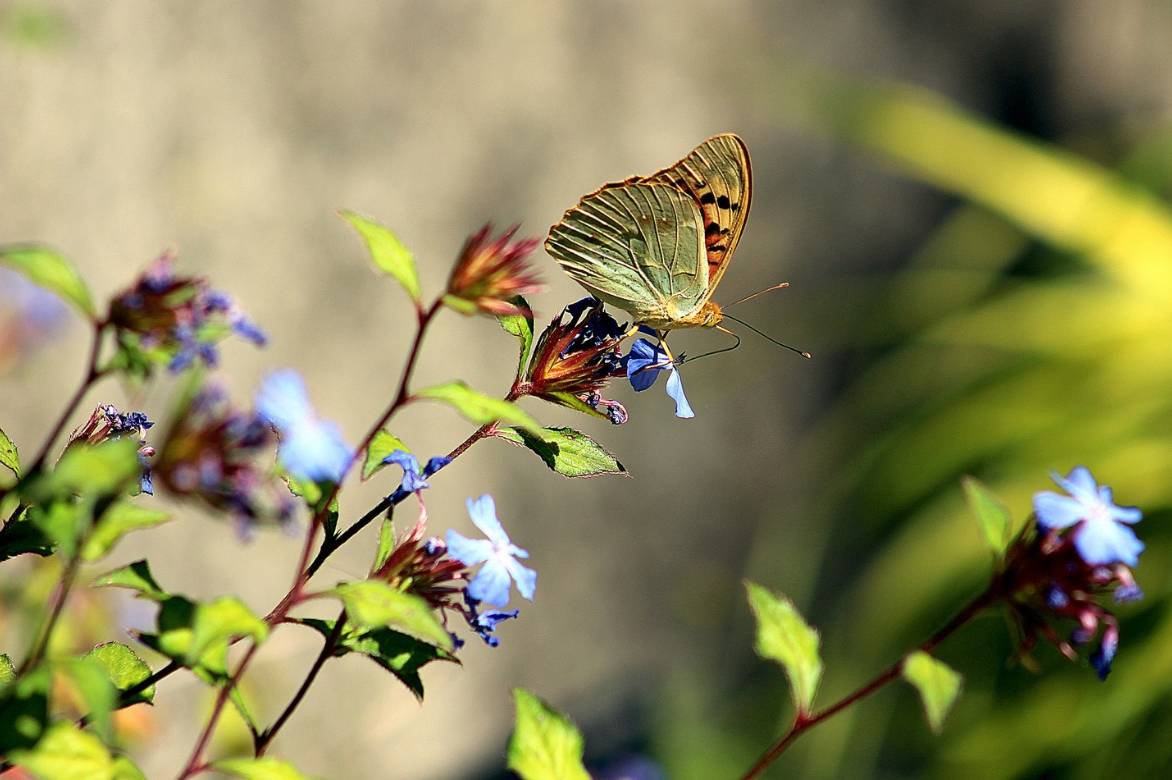
(photo Manuel m.v. – Flickr)
Description and botany
Botanical data
- Latin name Ceratostigma
- Family Plumbaginaceae
- Common name Chinese plumbago, Chinese leadwort
- Flowering from July to October
- Height between 0.30 and 1.20 m
- Exposure sun or partial shade
- Soil type any loose and well-drained soil, even calcareous
- Hardiness Good (-12 °C to -20 °C)
Ceratostigma are perennial herbaceous plants or small spreading bushes with fine, densely ramified stems belonging to family Plumbagos, a name they formerly bore. Genus comprises eight species native to Himalaya and Far East, with one species native to Somalia. They are commonly called Chinese plumbagos to distinguish them from Plumbago from the Cape, a much less hardy bush from South Africa with pale blue or white tones often seen on Mediterranean coasts. They belong to family Plumbaginaceae.
Ceratostigma plumbaginoides (syn. Plumbago larpentae) is sometimes called creeping Plumbago because of its tendency to colonise soil via reddish running rootstocks. Rapid-growing, this herbaceous plant is extremely ground-covering even though it dies back in winter and starts late, around May. First introduced to Germany from western China in 1834 by Alexander von Bunge, it made a second notable appearance in England in 1846 from Shanghai via the Larpent family, who helped promote it.
This perennial grows in rather dry, poor, sunny rock garden areas. Plant does not exceed 30 cm in height, but can spread over large distances in cool ground. It is also more frost-resistant (-20 °C) than bushy species (-12 to -15 °C), which can nevertheless regrow from collar.

Ceratostigma plumbaginoides – botanical illustration
From its woody stump emerge fine quadrangular stems, often purplish, bearing alternate, broadly ovate leaves with pointed tips, 3–5 cm long and 2.5–3 cm wide. Lamina is bright green, edged with dark, brownish to purplish cilia. Foliage often takes on bronze then vivid raspberry-red hues with first autumn frosts from September and falls rather late. Colour intensity is stronger where plant is exposed to sun.
Bushy species are deciduous or semi-evergreen and show a bushy habit slightly wider than tall, reaching 80–100 cm depending on species. Wilmott’s plumbago (C. willmottianum), native to Sichuan, has a loose habit, more vigorous than Ceratostigma griffithii from Himalaya. Its dark green leaves, golden in ‘Sapphire Ring’, rhomboid and about 5 cm long, bear fairly long hairs on margins and both faces and turn orange-red in autumn. Griffithi’s leaves remain evergreen in mild climates, are pubescent and thicker with a spatulate shape, scarcely exceeding 2–3 cm in length, dull green marginate with violet and carried on reddish stems. In all cases leaves are sessile and alternate. Fine quadrangular stems reshoot directly from collar after frost of aerial parts, knowing that well-drained soil increases frost tolerance of leadworts. Leaves turn red in autumn.
Flowering can begin as early as July depending on climate, notably in plumbaginoides, somewhat later for others, and can continue until frosts in October–November. Corolla of leadworts, supported by a tubular reddish calyx with fine teeth, forms a long narrow tube ending in five triangular lobes marked by a reddish vein that heightens brilliance of gentian-blue or cobalt-blue. Flower diameter ranges from 1 to 2 cm. Flowers appear and follow one another within axillary corymbs, grouped in loose clusters near stem tips. They are rich in nectar, attracting butterflies and bees. Stamens and pistils are not very conspicuous. Flower clusters give way to
Genus name Ceratostigma means “horned stigma”, the stigma being terminal part of pistil that receives pollen from other flowers. It divides into five parts, a character common to Chinese plumbagos.
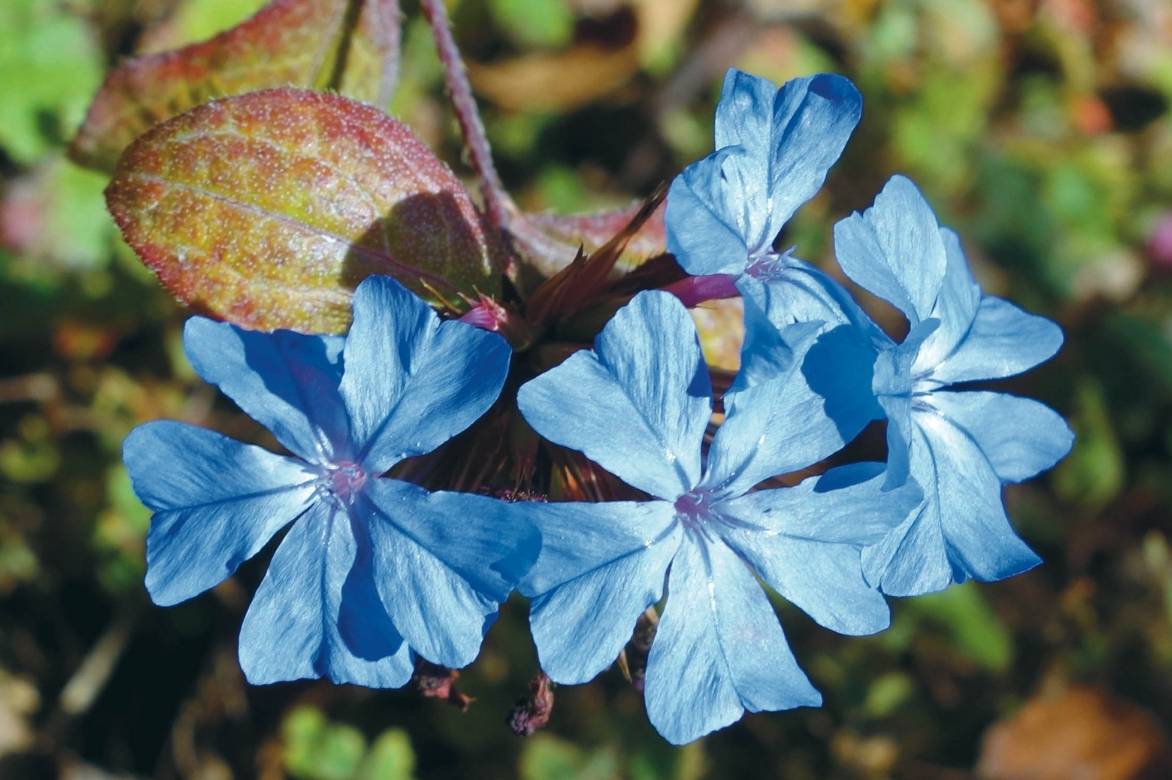
Intense deep-blue flowers of Ceratostigma willmottianum (photo Daderot)
Main varieties of Ceratostigma

Ceratostigma plumbaginoides
- Flowering time September to November
- Height at maturity 30 cm

Ceratostigma griffithii
- Flowering time September to November
- Height at maturity 80 cm

Ceratostigma willmottianum
- Flowering time September to December
- Height at maturity 1 m
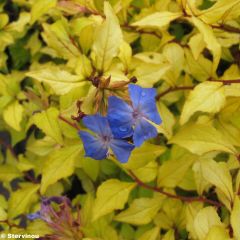
Ceratostigma willmottianum Sapphire Ring
- Flowering time August to December
- Height at maturity 80 cm
Discover other Ceratostigma
View all →Available in 2 sizes
Available in 2 sizes
Available in 2 sizes
Available in 2 sizes
Available in 1 sizes
Planting
Where to plant leadwort?
Plant Ceratostigma in full sun or partial shade, in light soil, even poor, calcareous and stony. They prefer well-drained, gravelly soils, rather neutral to calcareous and so adapt very well to summer drought. Choose a sheltered spot to make the most of its late-season flowering, especially for shrubby varieties. They can be planted against a wall or at the foot of a clematis to shade its base even if soil is poor.
Limit excessive growth in cool, rich soil of Larpent leadwort by pulling out its rootstocks, which are easy to remove.
When to plant?
Plant Ceratostigma preferably in spring in cold climates or in autumn to ensure deep rooting before facing summer drought.
How to plant?
This plant is easy to grow.
- Immerse rootball in a bucket of water to thoroughly moisten it.
- Dig a hole three times wider than rootball and loosen soil around with tines of a garden fork.
- Add a few handfuls of sand and gravel to ensure good drainage around roots. In heavy soil, choose planting on a raised mound or in a rockery.
- Add well-rotted manure or compost if soil is sandy.
- Place plant in planting hole.
- Replace soil and firm gently.
- Water.
In a large terracotta pot, place a layer of clay balls at the bottom and add a good potting compost for flowering plants mixed with draining materials (sand, vermiculite, perlite…). Add slow-release organic fertiliser or capsules in spring.
→ Read also : growing Ceratostigma in a pot.
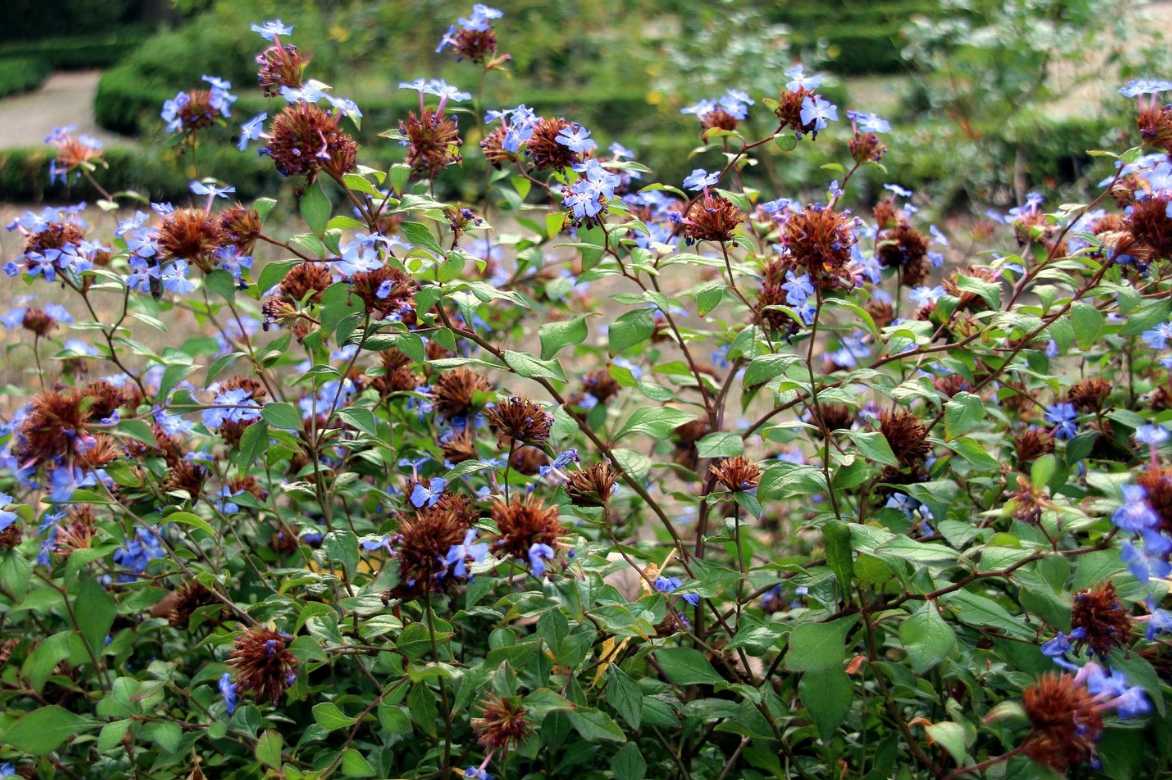
Ceratostigma (photo Manuel m.v. – Flickr)
Care
Cut back the shoots of shrubby plumbagos by about one third when growth resumes, to thicken the clump. Otherwise remove dried stems by pulling them off.
Water during prolonged drought, notably the species C. willmottianum which prefers cool soil, especially when it resumes growth. Growth is generally fairly rapid unless it lacks water. Place the pot against a wall with good sun exposure during winter or bring it into a garage.
This plant is not prone to diseases and parasitic pests in our gardens. Do not worry if you do not see it start in spring; it can be rather slow to show its best until mid and late season.
→ Learn more about pruning plumbago in our tutorial : How to prune plumbago?
Propagation: propagation by cuttings, sowing
Easiest propagation is by dividing the clump, but shrubby forms can also be obtained by propagation by cuttings of terminal tips in May–June.
Propagation by cuttings
Prepare a deep pot by filling it with potting compost mixed with sand.
- Take herbaceous tip cuttings about 10 cm long.
- Remove leaves located near base of cutting.
- Insert these to two-thirds of their length, avoiding contact between cuttings.
- Firm compost gently all around to eliminate air pockets and ensure good contact between potting compost and cutting.
- Keep them covered in shade, for example by placing a cut clear plastic bottle over them.
- In autumn, separate rooted cuttings and plant them into buckets which you keep under cold frame until spring.
- Plant out in spring in open ground.
→ Find out more in our tutorial : How to propagate Plumbago?
Sowing
Collect natural sowings you can find around shrubby varieties in particular.
Uses and companion planting
These low-maintenance, hardy groundcover plants tolerate root competition so well that they can be planted at the base of a tree or bush with deciduous leaves or of a climbing plant. Clematis montana ‘Freda’ offers, for example, pretty cut leaves tinged with purple in spring and again in autumn, providing a delicate backdrop to the lush electric-blue and bronze clump of Ceratostigma.
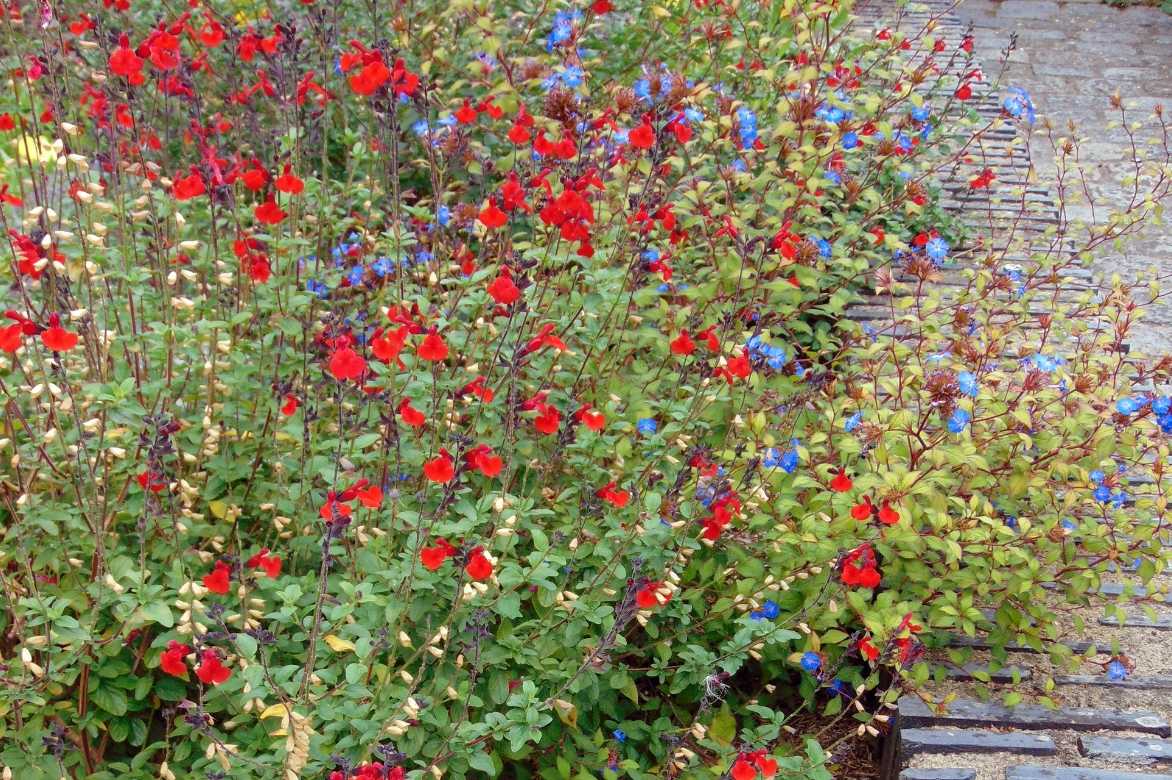
An example of a combination for a colourful border: Ceratostigma plumbaginoides and red Salvia microphylla such as variety ‘Royal Bumble’ in a rich deep red
Sunny rockeries, rather poor banks, low walls, path edges, the base of bushes planted in ground or in a large pot give Ceratostigmas the opportunity to express themselves and spill over generously.
Species of shrubby habit can form small low hedges with free habit paired with drought-tolerant bushes such as caryopteris, perovskia, potentilla, rosemary, cistus or summer spireas…
Create modern pot displays, flashy and graphic in autumn, by pairing Ceratostigma griffithii or willmottianum with grasses, asters, phormiums, Nandina, Sedum spectabile, silvery foliage of artemisia or santolina, and blue sages (Salvia nemorosa Caradonna, guaranatica, uliginosa)…
→ More ideas for pairing with Plumbago in our Advice Sheet !
Further reading
- Discover our range of Ceratostigma
- Discover 6 ideas for pairing Ceratostigma
- Our tips to choose the right Ceratostigma for your garden
- Do you like bushes with blue flowers? Discover our article: 8 bushes with blue flowers you should have in your garden
- Discover 8 climbing plants with blue flowers you should have in your garden in Gwenaëlle’s advice sheet
- Subscribe!
- Contents
































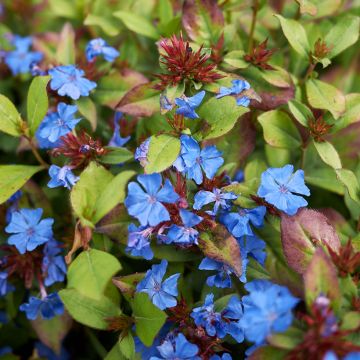
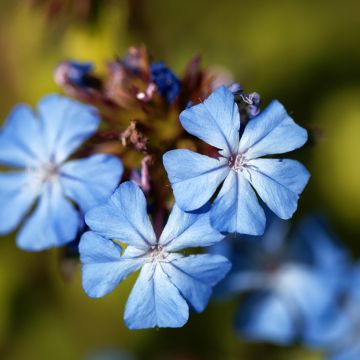
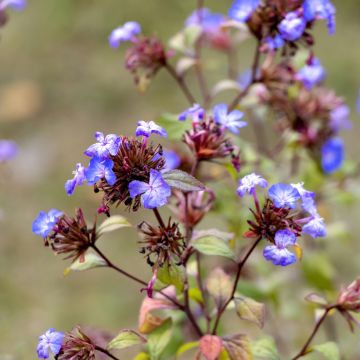


Comments